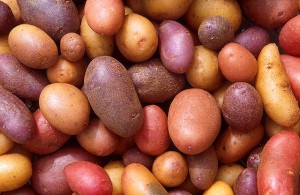
Potato varieties just may be the spice of life.
The humble potato is a tuberous vegetable. Some give it a bad reputation. Many consider it to be a massive source of calories and little nutritional value. This is wrong. Most potato shortcomings result, not from the potato, but from the way in which it is prepared.
As an example, consider the potato chip: thin potato wedges fried in oil and practically dipped in salt. Or what about the baking potato? Is it served with great gobs of sour cream or, perhaps butter or cheese? Even potato salad is hard to rationalize as salad. Chunks of potato goodness set in a veritable sea of high-fat dressing?
Bad for You?
Actually, the potato is quite nutritious and not as bad for us as some seem to think.1 Potato Goodness Unearthed informs us that the potato is 100 percent gluten-free. When consumed with its skin, a medium potato provides Joe Average nearly a half-day’s Vitamin C and a sizable portion of his potassium. It also contains much Vitamin B6 and dietary fiber. But what about sodium, fat, and cholesterol? The potato has none of those! Often unrecognized, potatoes are a source of certain antioxidants. Especially is this so for the purple and red tuber varieties.
Starch—Varieties, Levels and Characteristics
Starch is present in all potatoes. However, there is more of it in mature tubers. Early in the growth process, potatoes are at their peak sugar content. This is because growth is rapid. The transport of sugars, from their point of manufacture within the leaves, occurs more rapidly than conversion of the sugars within the tubers into starch. Generally, lower sugar levels are desired. At high heat the sugars caramelize, causing sticking in the skillet.
But how does nutrition vary among the potato varieties? Before directly answering that question, consider rice. Rice is sold by grain lengths—long, medium, and short grain. Due to an abundance of amylose (a curled but straight-chained starch), cooking long-grain rice yields tender, separable grains. Short-grain rice (often used to prepare a risotto) is saucy due to its high level of amylopectin with its branched starch molecules.
Potato varieties also contain differing levels of amylose and amylopectin. Loosely classified into baking and boiling varieties, baking potatoes (which are comparable to long-grain rice) contain a higher proportion of amylose. On the other hand, boiling potatoes afford higher levels of the branched amylopectin.
As to diet, starch, and the “Glycemic Index,” there are varying opinions and methods of reckoning. These differences can be lessened by applying the common-sense logic of eating a variety of different foods in moderacy.
Preparative Methods Influence Nutrition
The nutrition we derive from our potatoes is affected by the manner in which we cook them. Although most of the nutrition of a potato is not in the skin (as the old wives’ tale claims it is), potato skin does contain a good deal of fiber. It is advisable to prepare the skin with the flesh, when practicable. Perhaps un-intuitively, cooking a potato in the microwave rather than in a conventional oven, helps maintain nutritional value. More obviously, steaming is superior to boiling.
1 Of course, as is the case with practically any food one would care to mention, there are individuals with dietary issues who should avoid eating potatoes.
Note: You might also enjoy Why are Some Bananas Sweeter than Others?
References:
- University of Idaho: Lectures – Potato Storage, Chapter 16
- Potato Goodness Unearthed: Potato Nutrition

[…] White or colored potatoes have good nutritional value comparable to kale, Brussels sprouts and spinach. A potato is rich in potassium and contains half-days Vitamin C. If the potato is steamed and eaten as is without globs of butter and sour cream it is fat-free. Also, the potato is a gluten-free food! (Quirky Science,2012) […]